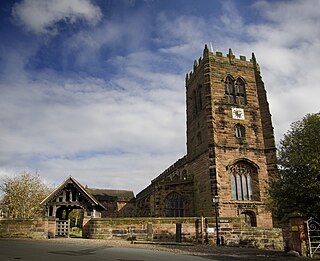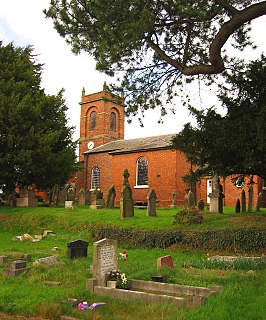
Wroxham is a village and civil parish in the English county of Norfolk. The civil parish of Wroxham has an area of 6.21 square kilometres and in 2001 had a population of 1532 in 666 households, reducing to a population of 1,502 in 653 households at the 2011 Census. The village is situated within the Norfolk Broads on the south side of a loop in the middle reaches of the River Bure. It lies in an elevated position above the Bure, between Belaugh Broad to the west and Wroxham Broad to the east or south east. Wroxham is some eight miles north-east of Norwich, to which it is linked by the A1151 road. The village and broad lie in an area of fairly intensive agriculture, with areas of wet woodland adjoining the broad and river. For the purposes of local government, the parish falls within the district of Broadland although the river, broad and their immediate environs fall within the executive area of the Broads Authority. On the northern side of the Bure is the village of Hoveton, often confused with Wroxham.

St Mary and All Saints Church is in the centre of the village of Great Budworth, Cheshire, England. It is an active Anglican parish church in the diocese of Chester, the archdeaconry of Chester and the deanery of Great Budworth. The church is recorded in the National Heritage List for England as a designated Grade I listed building. Clifton-Taylor includes it in his list of 'best' English parish churches. Richards describes it as "one of the finest examples of ecclesiastical architecture remaining in Cheshire". The authors of the Buildings of England series express the opinion that it is "one of the most satisfactory Perpendicular churches of Cheshire and its setting brings its qualities out to perfection".

St Mary's Church is in the village of Weaverham, Cheshire, England. The church is recorded in the National Heritage List for England as a designated Grade I listed building. It is an active Anglican parish church in the Diocese of Chester, the archdeaconry of Chester and the deanery of Middlewich.

The Church of St Mary the Virgin is in the village of Wistaston, Cheshire, England. The church is recorded in the National Heritage List for England as a designated Grade II listed building. It is an active Anglican parish church in the diocese of Chester, the archdeaconry of Macclesfield and the deanery of Nantwich.

The Church of St Helen, Ranworth, Norfolk is a church of medieval origins notable for its collection of church paintings. Known as "the cathedral of The Broads", the church dates from the 14th century, although with origins in Saxon times. It contains a major collection of medieval artefacts, in particular the rood screen and the Ranworth Antiphoner, a liturgical manuscript.

Wykeham Terrace is a row of 12 early 19th-century houses in central Brighton, part of the English city of Brighton and Hove. The Tudor-Gothic building, attributed to prominent local architect Amon Henry Wilds, is built into the hillside below the churchyard of Brighton's ancient parish church. Uses since its completion in 1830 have included a home for former prostitutes and a base for the Territorial Army, but the terrace is now exclusively residential again. Its "charming" architecture is unusual in Brighton, whose 19th-century buildings are predominantly in the Regency style. English Heritage has listed the terrace at Grade II for its architectural and historical importance.

St Mary's is an Anglican parish church in Elsing, a small village and civil parish in the Breckland district of Norfolk, England. The 14th-century church was built to a single plan in Decorated Gothic style by a local knight and has remained largely unaltered to the present day. The church contains a brass monument of national importance, a tall medieval font cover and rood screen paintings. The chancel retains some stained glass contemporary with the construction of the building.

Richard Makilwaine Phipson (1827–1884) was an English architect. As diocesan architect for the Anglican Diocese of Norwich, he was responsible for renovating almost 100 churches in East Anglia.

Thomas Earp (1828–1893) was a British sculptor and architectural carver who was active in the late 19th century. His best known work is his 1863 reproduction of the Eleanor Cross which stands at Charing Cross in London. He specialised in sculpture for Gothic Revival churches and worked closely with the architect George Edmund Street in the 1860s and 1870s.

St Mary’s Church, Wreay is the Church of England parish church of Wreay in Cumbria. It was designed by Sara Losh in about 1835 and built between 1840 and 1842. It is notable as the earliest known example in Britain of a revival of Lombard architecture. It is a Grade II* listed building.
John Bond Pearce was an English architect from Norwich, Norfolk. His architectural practice was in Surrey Street, Norwich. His son Neville Bond Pearce was also a noted architect. Pearce designed many of his building in the Victorian Gothic architectural style, a good example being the town hall in Great Yarmouth opened in 1882.

The Boathouse on Boathouse Pond, Belton House, Belton, Lincolnshire was designed by Anthony Salvin in 1838-9. It is a Grade II listed building.

The Monument to Grace Darling, in the churchyard of St Aidan's Church, Bamburgh, Northumberland is a Victorian Gothic memorial. The monument was designed by Anthony Salvin, with later renovations by Frederick Wilson, C. R. Smith and W. S. Hicks. Grace Darling was born on 24 November 1815, the daughter of the lighthouseman at Longstone Lighthouse. In 1838, Darling became a national heroine when she and her father rescued nine people from the wreck of the SS Forfarshire, a ship that had run aground off Big Harcar, an island off the Northumbrian coast. Darling died, aged 26, in 1842 and the monument was raised some distance to the north of her grave to make it viewable to passing sailors,at the west edge of the churchyard in the same year. It is a Grade II* listed structure.

Rudby Hall, Hutton Rudby, Skutterskelfe, North Yorkshire is a country house dating from 1838. Its origins are older but the present building was built for the 10th Viscount Falkland and his wife by the architect Anthony Salvin. The house is Grade II* listed.

Mamhead House, Mamhead, Devon, is a country house dating from 1827. Its origins are older but the present building was constructed for Robert William Newman, an Exeter merchant, in 1827–1833 by Anthony Salvin. The house is Grade I listed. The parkland has its own Grade II* listing. It was for a time known as Dawlish College.

Ryston Hall, Ryston, Norfolk, England is a 17th century country house built by Sir Roger Pratt for himself. The house was constructed between 1669 and 1672 in the Carolean style. In the late 18th century, John Soane made alterations to the house, and further work on the building was carried out by Anthony Salvin in the mid-19th century. Ryston Hall is a Grade II* listed building.
















